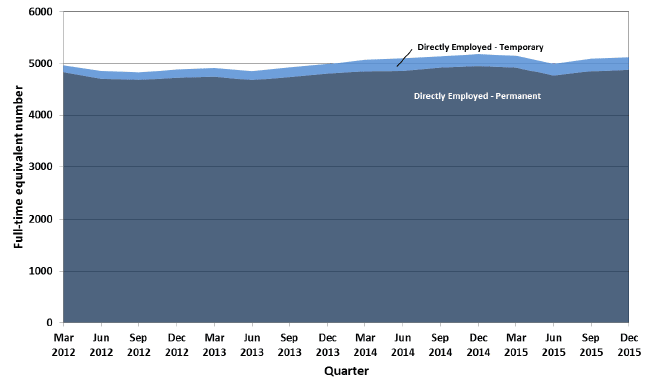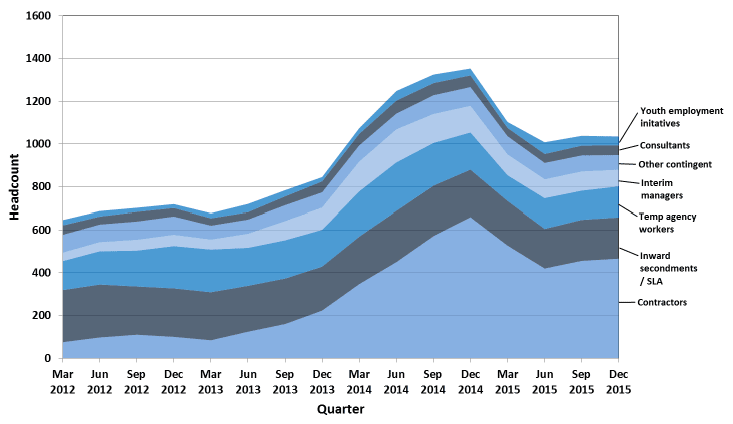Scottish Government Workforce Information 2015
This publication presents statistics on the Scottish Government’s workforce for each quarter from 2012 up to the most recent quarter at the end of 2015. The statistics show: numbers of directly employed staff by category, numbers of non-directly employed workers by category, staff sickness absence, and staff diversity information.
3. Scottish Government workforce numbers
Full time equivalent (FTE) numbers of directly employed staff
3.1 This section presents full-time equivalent (FTE) numbers of directly employed Scottish Government staff (Chart 1, Table 1). Directly employed staff are those that are employed on the Scottish Government's terms and conditions (see Annex B for further information about the directly employed staff categories). Directly employed staff, who are not being paid, such as those on career breaks, are excluded from Table 1. Headcounts of directly employed staff follow the same pattern as FTE numbers, and are shown in Table C1 in the Annex.
3.2 The full time equivalent (FTE) measure accounts for differences in working hours within the Scottish Government, as part-time working or job-sharing is available to suit personal circumstances. The measure is given as a proportion of the number of hours worked in a week, compared to the working hours in a standard full-time working week. A full-time member of staff works 37 hours a week and is assigned a FTE value of 1. A staff member that works half the number of hours a week of a full-time member of staff (18.5 hours/week), would be assigned an FTE value of 0.5, and so forth.
3.3 Directly employed staff are of two main types: permanent and temporary. Permanent staff includes those on paid maternity, adoption or shared parental leave, and those on outward secondment. Fixed term appointments (with competition), are included within the permanent category in this publication, because they have been recruited through fair and open competition, and may apply for an internally advertised vacancy at the end of their temporary post. Temporary staff includes those on fixed term contracts, or students on paid placements. Modern Apprentices are temporary employees who may be converted to permanent staff at the end of their apprenticeship, subject to meeting the necessary criteria. See Annex B for further details about staff categories.
Chart 1 FTE of directly employed staff

3.4 At the end of December 2015, there were 5,120 FTE directly employed staff in Scottish Government core directorates. Of these, 4,882 were permanent staff (95 per cent) and 237 FTE temporary staff (5 per cent) (Table 1). The number of 5,120 FTE directly employed staff is a net decrease of 68 full time equivalent staff from 5,188 in December 2014.
3.5 The number of permanent employees has remained relatively stable over the past four years, with a low of 4,681 at the end of June 2013 and a high of 4,951 FTE staff at the end of December 2014, a difference of 270. There was a net decrease of 69 FTE staff from December 2014 to 4,882 at the end of December 2015 (Table 1). A decrease in June 2015 can be explained in part by a voluntary exit scheme, as well as the transfer of Scottish Tribunals Service staff from the core Scottish Government to the Scottish Courts and Tribunals Service.
3.6 The Scottish Government is committed to employing Modern Apprentices. The number of modern apprentices in the Scottish Government has been increasing since the Modern Apprentice scheme was launched in January 2011. Since the start of the scheme, the core Scottish Government has taken on 215 Modern Apprentices, 115 have converted to permanent members of staff, 81 FTE Modern Apprentices were still completing their apprenticeship at the end of December 2015 (Table 1), while 19 left the organisation before completing their apprenticeship. Although Modern Apprentices are employed on fixed term contracts it is expected that they will become permanent employees on completion of the programme and passing a competitive selection interview.
Contingent Worker Headcounts
3.7 In addition to directly employed staff, there are non-directly employed workers engaged in work for the Scottish Government. These are termed contingent workers throughout this publication. These are often workers that are engaged for short term projects requiring specialist skills that are not available in-house, such as contractors, interim managers, consultants and temporary agency workers. Some consultants and contractors are brought in under a contract which has been let to an external organisation to supply a specific service or product. In this circumstance the numbers of consultants and contractors can vary depending on how the external supplier choses to resource the contract. Also some contingent workers may only work a few hours per week or month. As they can vary from one week to the next, the number of hours worked by contingent workers are not recorded on the Scottish Government’s HR system. Therefore this section presents the headcount of contingent workers rather than FTE (Chart 2, Table 2). Contingent workers also include inward secondments and those on talent programmes (such as the UK Civil Service Fast Stream) and short-term youth employment initiatives.
Chart 2 Headcount of contingent workers
Note that UK Civil Service Fast Stream are excluded due to small numbers.

3.8 At the end of December 2015, the total headcount of contingent workers engaged by the Scottish Government was 1,042 (Table 2). 45 per cent of these were contractors with a headcount of 466. This is a net decrease of 312 contingent workers from 1,354 at the end of December 2014.
3.9 The number of contingent workers more than doubled from 646 in March 2012 to their highest level of 1,354 at the end of December in 2014, with most of the increase during 2014 (Table 2). This was mostly driven by an increase in the numbers of contractor staff, interim managers, and temporary agency workers. The headcount of non-directly employed workers fell in 2015, mostly due to contractors leaving (see section below). The decrease was also partially attributable to a data cleansing exercise during February and March 2015, which removed around 150 out of date records for non-directly employed workers from the HR system.
3.10 Contractors are temporary workers, typically brought in under a service contract which has been let to an organisation to deliver a specific product. These have been the biggest category of temporary workers since the end of 2013. The numbers of contractor staff increased steadily during 2012 and 2013. In 2014 the headcount of contractors increased significantly, from 223 at the end of December 2013, to 659 at the end of December 2014, an increase of 436 (Table 2). In 2015 the headcount of contractors decreased and was 466 at the end of December 2015, which is 193 lower than at the end of December 2014. A small part of this decrease was due to the data cleanse in February and March 2015 (see section 3.9).
Contact
Email: Andrew Morgan
There is a problem
Thanks for your feedback